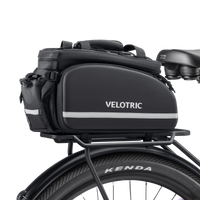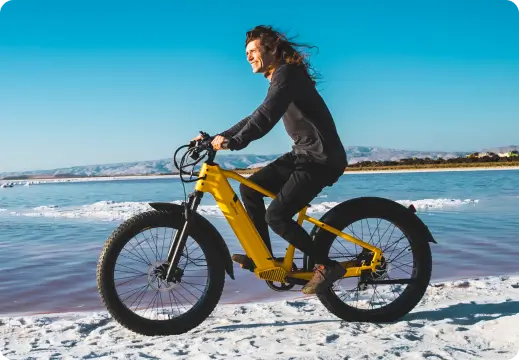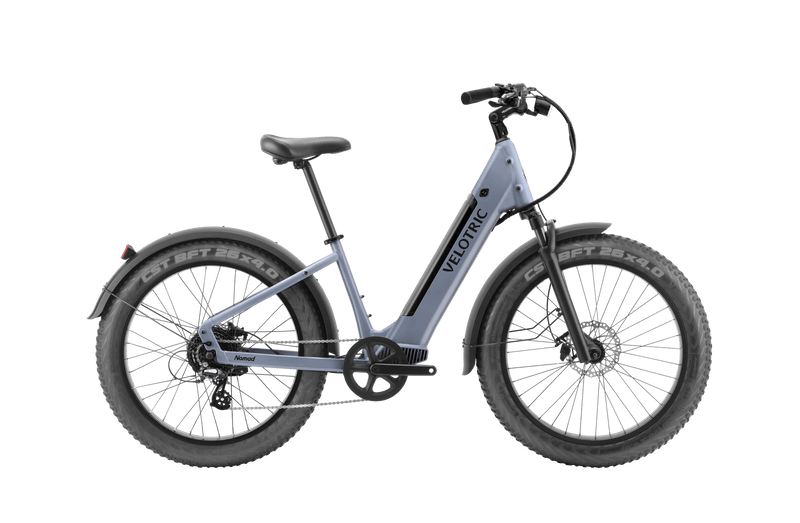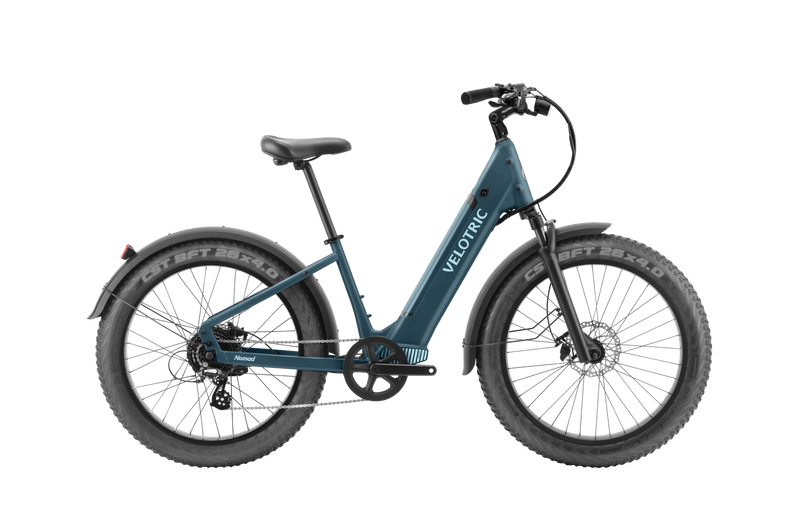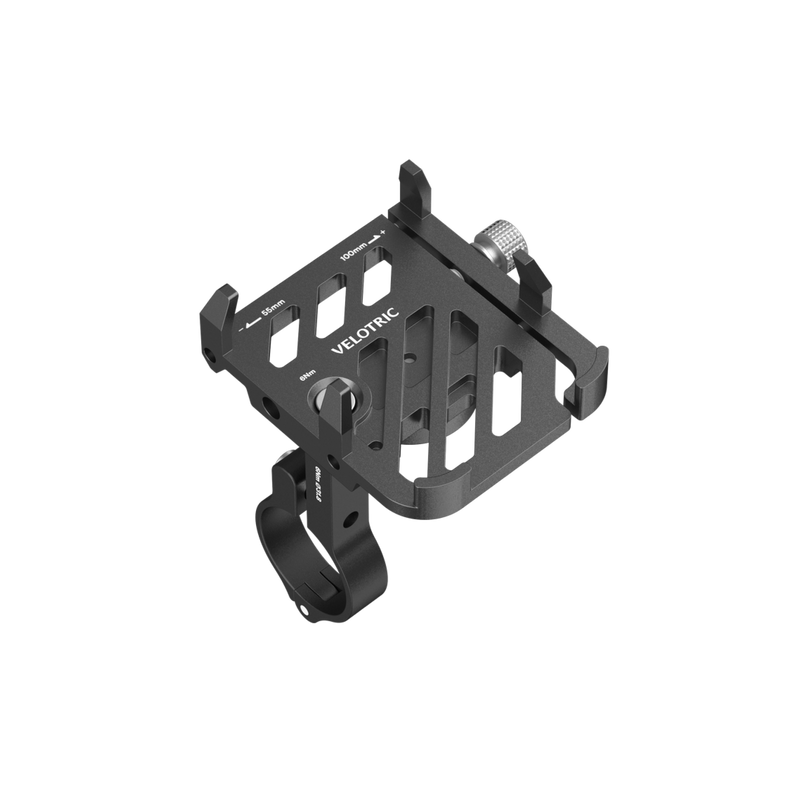Whether you ride an electric bicycle or a traditional two-wheeler, it's in your best interest to wear a helmet. Sure, we know it might not be the hottest look around, but it can be a life saver — literally.
This isn't just talk. Substantial research speaks to the effectiveness of helmets when it comes to preventing head injury.
One massive overview of bike helmet effectiveness looked at multiple studies conducted between 1989 and 2017. The results? Wearing a bicycle helmet reduced head injuries by 48%, and it reduced traumatic brain injuries (like concussions) by 53%.
Studies have looked at the effectiveness of bike helmets when it comes to preventing pediatric brain injury as well, so it’s just as important to take this safety measure with children as it is with adults.
Clearly, wearing a helmet is critical if you’re a biker or e-bike rider. But is it mandatory? If you cycle down the street without a helmet on, will the police pull you over and issue a ticket? After all, if you were in a car and you weren't wearing a seatbelt, you could get pulled over.
The quick answer is this: There is no national bicycle helmet law. Every state has its own regulations regarding bicycle helmet requirements. What's more, those requirements may vary for minors versus adults.
Read on for a quick guide to bicycle helmet laws in the United States — and to learn why you should always wear one, regardless of the legal requirements (or lack thereof).
Is it mandatory to wear a bicycle helmet?
There is no country-wide bicycle helmet law. In the U.S., Legislation varies between states and according to factors like age. Below, you'll find a guide to the different statewide laws.
Remember, even if you live in an area where local laws don't require helmets, it's definitely a good idea to wear one.
Why?
Head injuries are especially common among cyclists. According to the National Safety Council, one-third of non-fatal injuries to bicycle riders are head injuries.
It makes sense. Unlike when you’re riding in a car, on a bike you don't have a seat belt holding you in place. There's no protective casing around you to keep you from being ejected from the seat — and flying off head-first.
If you have to brake suddenly and you’re thrown from your bike, you run the risk of injuring your head in the fall. A helmet provides protection in the case of a traumatic blow.
A helmet can make a big difference! Even if it's not required by your local ordinances, it's worth wearing one when you're cycling. This applies whether you're on a regular bicycle or an e-bike.
Bicycle helmet laws
Despite significant research indicating that bicycle helmets are a good thing, American lawmakers haven't passed a national law that makes this protective gear mandatory. Helmet use is regulated on a state-by-state basis.
Some states have no regulations while others require helmets for cycling. Some require children under a certain age to wear helmets, but they don't require adults to wear helmets.
Electric bicycle helmet laws
As it is with riding a traditional bike, the U.S. doesn't have a national law making it mandatory to wear a helmet when riding an electric bicycle. It's at the discretion of each state to decide what rules to put in place.
E-bike helmet requirements, like traditional bike requirements, can also vary according to age. Additionally, states may have different laws according to the "class" of e-bike.
There are three main classes of e-bikes:
- Class 1 e-bikes have no throttle and don't exceed speeds of 20 mph. This class of e-bike is pedal assist only.
- Class 2 e-bikes do have throttle assist, but they also can't exceed speeds of 20 mph.
- Class 3 e-bikes have no throttle, are pedal-assist only, and can't exceed speeds of 28 mph.
Both Velotric's Discover 1 and Nomad 1 e-bikes are class 2 e-bikes, which is widely accepted by most states as usable without any particular restrictions.

Bicycle helmet laws by state
Laws regarding helmet requirements for cyclists and e-bicyclists vary between states. Some states make helmet wearing mandatory while others don't have any laws at all. Some states have age-specific laws, making helmets mandatory only if you're under a certain age.
See the below table for a comprehensive list of bike helmet laws state-by-state. These laws apply to both regular bikes and e-bikes.
The information about regular bike helmet laws is compiled from the Insurance Institute for Highway Safety (IIHS) and Highway Loss Data Institute (HLDI). The information about e-bike helmet laws comes from the Bicycle Helmet Safety Institute.
Remember, it's important to check your state's helmet legislation regularly, since laws can change with time. The data on this table dates from October 2022.
| State | Bicyclists required to wear helmet | E-bicyclists required to wear helmet |
| Alabama | Required for those 15 years of age and younger. | Helmet required for all classes of e-bikes, for all ages. |
| Alaska | No law. | No statewide law; local bike requirements apply. |
| Arizona | No law. | No statewide law; local bike requirements apply. |
| Arkansas | No law. | Required for class 3 riders under 21 years of age. |
| California | Required for those 17 years of age and younger. | Required for class 1 and 2 riders under 18 years of age, and for class 3 riders of all ages. |
| Colorado | No law. | Required for class 3 riders under 21 years of age. |
| Connecticut | Required for those 15 years of age and younger. | Required for class 1 and 2 riders under 16 years of age, and for class 3 riders of all ages. |
| Delaware | Required for those 17 years of age and younger. | Required for all classes under 18 years of age. |
| District of Columbia | Required for those 15 years of age and younger. | Required for all classes under 16 years of age. |
| Florida | Required for those 15 years of age and younger. | Required for all classes under 16 years of age. |
| Georgia | Required for those 15 years of age and younger. | Required for class 1 and 2 riders under 16 years of age, and class 3 riders of all ages. |
| Hawaii | Required for those 15 years of age and younger. | Required for all classes under 16 years of age. |
| Idaho | No law. | No law. |
| Illinois | No law. | No statewide law; local bike requirements apply. |
| Indiana | No law. | Required for class 3 riders under 18 years of age. |
| Iowa | No law. | No requirement. |
| Kansas | No law. | No statewide law; local bike requirements apply. |
| Kentucky | No law. | No statewide law; local bike requirements apply. |
| Louisiana | Required for those 11 years of age and younger. | Required for class 3 riders of all ages. |
| Maine | Required for those 15 years of age and younger. | Required for all classes under 16 years of age. |
| Maryland | Required for those 15 years of age and younger. | Required for all classes under 16 years of age. |
| Massachusetts | Required for those 16 years of age and younger. | Required for all classes for riders of all ages. |
| Michigan | No law. | Local bike requirements apply for class 1 and 2 riders of all ages. Statewide required for class 3 riders under age 16. |
| Minnesota | No law. | No requirement. |
| Mississippi | No law. | No statewide law; local bike requirements apply. |
| Missouri | No law. | No statewide law; local bike requirements apply. |
| Montana | No law. | No statewide law; local bike requirements apply. |
| Nebraska | No law. | No requirement. |
| Nevada | No law. | No statewide law; local bike requirements apply. |
| New Hampshire | Required for those 15 years of age and younger. | Required for class 1 and 2 riders under 16 years of age, and for class 3 riders under 18 years of age. |
| New Jersey | Required for those 16 years of age and younger. | Required for all classes of riders under 17 years of age. |
| New Mexico | Required for those 17 years of age and younger. | Moped law applies; required for all classes of riders under 18 years of age. |
| New York | Required for those 13 years of age and younger. | State and local bike helmet laws apply for class 1 and 2 riders. |
| North Carolina | Required for those 15 years of age and younger. | Required for all classes of riders under 16 years of age. |
| North Dakota | No law. | No requirement for "motorized bicycles." |
| Ohio | No law. | Local requirements apply for class 1 and 2 riders. Required for class 3 riders of all ages. |
| Oklahoma | No law. | Local requirements apply for all classes of riders. |
| Oregon | Required for those 15 years of age and younger. | Required for all classes for riders under 16 years of age. |
| Pennsylvania | Required for those 11 years of age and younger. | Required for all classes for riders under 12 years of age. |
| Rhode Island | Required for those 15 years of age and younger. | Required for all classes for riders under 16 years of age. |
| South Carolina | No law. | No requirement. |
| South Dakota | No law. | No requirement. |
| Tennessee | Required for those 15 years of age and younger. | Required for class 1 and 2 riders under 16 years of age, and class 3 riders of all ages. |
| Texas | No law. | Local requirements apply for all classes. |
| Utah | No law. | No requirement. |
| Vermont | No law. | No requirement. |
| Virginia | No law. | Local requirements apply for class 1 and 2 riders. Required for class 3 riders of all ages. |
| Washington | No law. | Local requirements apply for all classes. |
| West Virginia | Required for those 14 years of age and younger. | Required for class 1 and 3 for riders under 15 years of age. Any local requirements also apply. |
| Wisconsin | No law. | No statewide law; local bike requirements apply. |
| Wyoming | No law. | No requirement. |
Cities that require bicycle riders to wear helmets
As you can see from the table above, helmet laws vary drastically between states. Some have zero regulation while others are more strict. What’s more, some cities have their own helmet laws, and these can differ from state regulations.
Here are three examples of cities that take a different approach to helmet laws:
- New York City, New York: In New York State, bicycle helmets are required for anyone under 14 years of age. When it comes to class 1 and class 2 e-bike riders, state and local helmet laws apply. In New York City, however, class 1 and 2 riders under 18 must wear helmets. Working cyclists (like couriers) are also required to wear helmets. For class 3 riders, everyone is required to wear a helmet regardless of age or profession.
- Louisville, Kentucky: Kentucky doesn't have any statewide laws for wearing helmets for either e-bike riders or traditional bikers. However, Louisville has its own rules for traditional cyclists. Anyone under 18 years of age riding in a Louisville Metro Park must wear a helmet.
- Los Angeles, California: Los Angeles, California requires bicycle riders 17 years of age and younger to wear helmets. Helmets are also required for class 1 and 2 riders under 18 years of age and class 3 riders of all ages.
As you can see, regulations vary depending not only on location but also on factors like age and whether you're on a bicycle or an e-bicycle. It's best to check directly with your local authority to see what rules apply to you.
Why are helmets mandatory in some states?
Some cities or states have enacted their own helmet laws in efforts to protect public wellbeing.
Why? The benefits are clear. This protective headgear can prevent serious injury and save lives. The statistics and studies mentioned at the beginning of this article illustrate that well enough. Experts in traffic safety confirm benefits, and helmet use is broadly recommended by some of the most respected health and safety agencies in the U.S. government.
The Department of Transportation's National Highway Safety Administration (NHTSA) has identified bicycle helmets as one of the "countermeasures that work" in protecting both children and adults on the road.
Similarly, the Centers for Disease Control and Prevention have flagged wearing helmets as an important measure in protecting both adult and child bicycle riders.
The United States Consumer Product Safety Commission has emphasized the importance of wearing helmets — most recently in response to a scary statistic that showed more adults dying from bicycle accidents currently than they used to in the past.
By passing laws that make helmets mandatory for populations, cities and states are doing their part to protect their citizens.
Choosing a bike helmet
Convinced that you should always cycle (or e-cycle) with a helmet? Good! You've made a smart choice. To get the most out of your helmet, it's important to get a good-quality model that fits well.
When choosing a helmet, make sure the model you buy has been tested for safety — it should carry CPSC certification.
You also need to make sure that the helmet is properly sized and fitted for your (or your child's) head. Here are some pointers from the CDC to encourage proper wearing:
- Size. You can determine your head size using a soft tape measure. Wrap it around your head, placing the tape measure just above your eyebrows and ears. The tape measure should be level front to back. Check the helmet brand's sizing chart to determine if a helmet will fit you correctly (sizing varies between brands).
- Fit. The helmet should fit snugly around your head. There shouldn't be any spaces between the foam and your head. However, the helmet shouldn't be too tight, which could be uncomfortable and cause headaches.
- Position. Once the helmet is on your head, there should be one to two fingers’-width of space between the brim of your helmet and your eyebrows. This ensures a clear line of sight. At the back, your helmet's brim should be high enough to avoid touching the top of your neck.
- Adjustments. Some helmets come with removable padding or a fit ring that makes them easier to adjust. Every bike helmet comes with straps to secure it around your head. The side straps should make a "V" slightly in front of and beneath your ears. The chin strap should fit snugly but allow for one to two fingers’ width of space.
Remember, it’s important to revisit your helmet needs regularly. If you change your hairstyle, for example, your helmet could fit differently. And if a helmet has experienced an impact, it should be replaced,according to the CDC. Even if you can't see any visible damage, the helmet's integrity may suffer after a blow, making it less protective.
Prioritize safety while bike riding
Don't leave safety to chance when riding a bike or e-bike. Invest in a good-quality helmet that will protect you if you get into a crash. Even if helmets aren't mandatory in your city or state, it's worth safeguarding your body.
For reputable e-bikes with top safety features, trust Velotric. The Velotric Discover 2 and Velotric Nomad 2 both have safety features to protect riders including rear lights, hydraulic disc brakes, and bells. Velotric bikes are also IPX6 grade waterproof. Naturally they pass the ISO 4210 and EN 15194 certification for bicycles.
We've tested our bikes rigorously — more than 150,000 times — to make sure they hold up even in the toughest conditions.
Life on two wheels can be a lot of fun — and e-bikes offer some advantages. They promote health, and they’re environmentally friendly too. Advantages aside, at Velotric, safety is always the priority.
Browse our selection of tried-and-tested e-bikes now.
Data Sources
The above information is sourced from these websites and was last updated in November 2024. If you have any questions, you can visit the following sites directly for confirmation.
- ScienceDirect: Bicycle helmets – To wear or not to wear? A meta-analyses of the effects of bicycle helmets on injuries
- Springer Nature Link: Bike helmets prevent pediatric head injury in serious bicycle crashes with motor vehicles
- NSC: Bicycle Safety Statistics May Surprise You
- Iihs.org: Bicycle helmet use laws
- Dot.ny.gov: FAQ about Bicycling in New York
- Nyc.gov: Electric Bicycles & More
- LouisvilleKy.gov: Bike Laws
- Cpsc.gov: New CDC Report Finds More Adults Are Dying from Bicycle-Related Accidents; CPSC Says it Highlights the Importance of Helmets
- Cpsc.gov: Which Helmet for Which Activity?


























